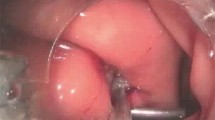Abstract
Background
The advancement of natural orifice translumenal endoscopic surgery (NOTES) into clinical practice is dependent on its safety, efficacy, and efficiency. Access is the obligatory first step in NOTES and serves as a surrogate to technical difficulties associated with this novel surgical approach. This study aimed to compare endoscopic transgastric access techniques in terms of safety, reproducibility, and efficiency.
Methods
Seven variations for anterior transgastric NOTES access were evaluated with female domestic swine. After marking of an anterior site, electrocautery was used to create a small gastrotomy, followed by balloon dilation and entry into the peritoneal cavity. Methodologic variations incorporated the use of guidewires, electrocautery and dilation combined within a single device, support tubes, and dilation without electrocautery. Access times were recorded, and tissue injury was evaluated.
Results
In 70 access attempts, the most serious complication was bleeding from the gastroepiploic vessel, controlled with electrocautery. High variability in access times was prevalent with almost all the access techniques.
Conclusions
This study supports the presumption that an anterior transgastric access technique for NOTES procedures is safe. The use of a wire to mark the site and another wire to retain the gastrotomy provided safe, efficient, and reproducible transgastric access. Comparison with laparoscopy exposed the disparity in technical challenges facing NOTES, suggesting that new technology and further refinement in methodology are required for NOTES to be clinically relevant.





Similar content being viewed by others
References
Kalloo AN, Singh VK, Jagannath SB, Niiyama H, Hill SL, Vaughn CA, Magee CA, Kantsevoy SV (2004) Flexible transgastric peritoneoscopy: a novel approach to diagnostic and therapeutic interventions in the peritoneal cavity. Gastrointest Endosc 60:114–117
Lacy AM, Delgado S, Rojas OA, Almenara R, Blasi A, Llach J (2008) MA-NOS radical sigmoidectomy: report of a transvaginal resection in the human. Surg Endosc 22:1717–1723
Dolz C, Noguera JF, Martín A, Vilella A, Cuadrado A (2007) Transvaginal cholecystectomy (NOTES) combined with minilaparoscopy. Rev Esp Enferm Dig 99:698–702
Zorrón R, Filgueiras M, Maggioni LC, Pombo L, Lopes Carvalho G, Lacerda Oliveira A (2007) NOTES. Transvaginal cholecystectomy: report of the first case. Surg Innov 14:279–283
Marescaux J, Dallemagne B, Perretta S, Wattiez A, Mutter D, Coumaros D (2007) Surgery without scars: report of transluminal cholecystectomy in a human being. Arch Surg 142:823–826 discussion 826–827
Zornig C, Emmermann A, von Waldenfels HA, Mofid H (2007) Laparoscopic cholecystectomy without visible scar: combined transvaginal and transumbilical approach. Endoscopy 39:913–915
Hazey JW, Narula VK, Renton DB, Reavis KM, Paul CM, Hinshaw KE, Muscarella P, Ellison EC, Melvin WS (2008) Natural-orifice transgastric endoscopic peritoneoscopy in humans: initial clinical trial. Surg Endosc 22:961–966
Gauderer MW, Ponsky JL, Izant RJ Jr (1980) Gastrostomy without laparotomy: a percutaneous endoscopic technique. J Pediatr Surg 15:872–875
Ponsky JL, Gauderer MW (1981) Percutaneous endoscopic gastrostomy: a nonoperative technique for feeding gastrostomy. Gastrointest Endosc 27:9–11
Rosen M, McGee M, Marks J, Chak A, Onders R, Faulx A, Ignagni A, Schomisch S, Ponsky J (2006) Optimizing peritoneal access for natural orifice transvisceral endoscopic surgery (NOTES) (abstract). Surg Endosc 20:S365
Sumiyama K, Gostout C (2008) Techniques for transgastric access to the peritoneal cavity. Gastrointest Endosc Clin North Am 18:235–244
von Delius S, Gillen S, Doundoulakis E, Schneider A, Wilhelm D, Fiolka A, Wagenpfeil S, Schmid RM, Feussner H, Meining A (2008) Comparison of transgastric access techniques for natural orifice transluminal endoscopic surgery. Gastrointest Endosc 68:940–947
Ko CW, Shin EJ, Buscaglia JM, Clarke JO, Magno P, Giday SA, Chung SS, Cotton PB, Gostout CJ, Hawes RH, Pasricha PJ, Kalloo AN, Kantsevoy SV (2007) Preliminary pneumoperitoneum facilitates transgastric access into the peritoneal cavity for natural orifice transluminal endoscopic surgery: a pilot study in a live porcine model. Endoscopy 39:849–853
Hondo FY, Giordano-Nappi JH, Maluf-Filho F, Matuguma SE, Sakai P, Poggetti R, Mori ND, Fontes B, Birolini D, Ishioka S (2007) Transgastric access by balloon overtube for intraperitoneal surgery. Surg Endosc 21:1867–1869
Kim CY, Chun HJ, Kim JY, Jang JS, Kwon YD, Park S, Keum B, Seo YS, Kim YS, Jeen YT, Lee HS, Um SH, Lee SW, Choi JH, Kim CD, Ryu HS (2008) Accessibility of peritoneal organs according to the routes of approach in NOTES. Korean J Gastroenterol 52:281–285
Sporn E, Miedema BW, Astudillo JA, Bachman SL, Loy TS, Davis JW, Calaluce R, Thaler K (2008) Gastrotomy creation and closure for NOTES using a gastropexy technique. Gastrointest Endosc 68:948–953
McGee MF, Rosen MJ, Marks J, Chak A, Onders R, Faulx A, Schomisch S, Ponsky J (2007) A reliable method for monitoring intraabdominal pressure during natural orifice translumenal endoscopic surgery. Surg Endosc 21:672–676
Disclosures
Jeffrey M. Marks receives an honorarium as a consultant for Covidien, Olympus, Boston Scientific, WL Gore, and Ethicon and for serving on the advisory board for Apollo Endosurgery. Jeffrey L. Ponsky serves as a consultant for US Endoscopy. Steve J. Schomisch, Joseph P. Furlan, Jamie M. Andrews, and Joseph A. Trunzo have no conflicts of interest or financial ties to disclose.
Author information
Authors and Affiliations
Corresponding author
Rights and permissions
About this article
Cite this article
Schomisch, S.J., Furlan, J.P., Andrews, J.M. et al. Comparison of anterior transgastric access techniques for natural orifice translumenal endoscopic surgery. Surg Endosc 25, 3906–3911 (2011). https://doi.org/10.1007/s00464-011-1818-7
Received:
Accepted:
Published:
Issue Date:
DOI: https://doi.org/10.1007/s00464-011-1818-7




